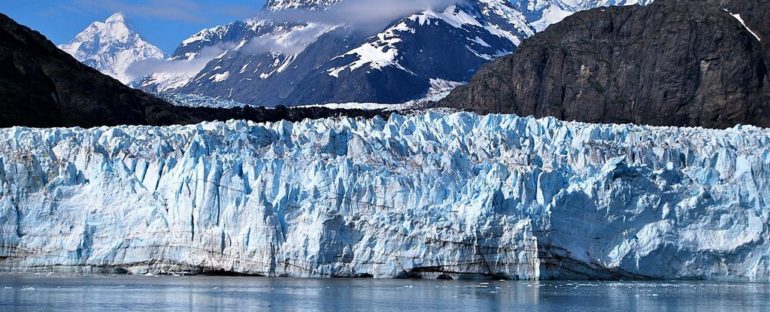As the enormous weight of Alaska’s glaciers rapidly melts away, the land underneath is rising upwards once again, like a feathery pillow after pressure is removed.
According to a new model, that rebounding motion could be causing local tectonic plates to strain at their seams, making it easier for earthquakes to occur.
Comparing ice loss, shear stress, and seismic records in southwest Alaska from 1920 onwards, researchers found most large earthquakes were linked to long-term earth rebound.
Across the region, adjustments in glacial mass from ice melt increased stress along the underlying fault line, promoting at least 23 of 30 earthquakes with magnitudes over 5.0.
The relationship is subtle yet unmistakable and is especially clear in 1958 when a magnitude 7.8 earthquake triggered a historical landslide and a massive tsunami in Lituya Bay.
Since 1770, the Glacier Bay Icefield near Lituya Bay has lost over 3,000 square kilometers of ice (nearly 1,200 square miles), thinning the icefield by up to 1.5 kilometers (0.9 miles).
The fastest earth uplift during this time was centered on those areas that experienced the greatest ice melt, and this occurred directly alongside the Fairweather fault line.
What’s more, the epicenter of the 1958 earthquake was very close to the location where ice load change-induced rebound stress was greatest between 1770 and 1958.
While rapid tectonic loading is still thought to be the main driver behind high magnitude earthquakes in this region, the authors say glacier ice loss is also playing a smaller yet significant accompanying role.
The fault lines in southeast Alaska, where the Pacific and North American plates interact, frequently rupture in large earthquakes, but research suggests the weight of glaciers sitting on top of this land have been clamping down on some of the slipping, shearing, and sliding.
As this weight gets lifted, however, the subsequent land rise makes it easier for plates to slip past one another, and this might have an effect on the timing and severity of future earthquakes. In 1958, for instance, rising land from melting glaciers twisted the crust of the fault line, increasing stress near the earthquake’s epicenter.
It’s also worth noting the 1958 earthquake occurred in the warmest month of the year in southeast Alaska and in the warmest year the region had seen since 1944, which could have also promoted greater short-term ice loss.
“The movement of plates is the main driver of seismicity, uplift, and deformation in the area,” explains seismic risk scientist Chris Rollins who conducted this research whilst at the University of Alaska, Fairbanks.
“But postglacial rebound adds to it, sort of like the de-icing on the cake. It makes it more likely for faults that are in the red zone to hit their stress limit and slip in an earthquake.”
This doesn’t mean glacier melt is going to trigger earthquakes everywhere ice exists, just in areas where active fault lines lie close by or directly beneath.
Southwest Alaska is one of these places. Post-glacial rebound here is occurring at a rate of roughly 4 centimeters (1.57 inches) a year, among the fastest measured on Earth. Previous research in the area suggests a 1979 earthquake of magnitude 7.2 was promoted by rapidly melting glaciers nearby. In the decades leading up to this event, pressure along the underlying fault line began to build, just as many glaciers thinned substantially or even disappeared completely.
Greenland is another possible hotspot. Past studies have also found the worst earthquakes are mainly confined to areas of this nation where the thickest layers of ice are absent or where significant ice melt is occurring.
The new model supports these findings and teases out some of the details. If the fault line runs along the edge of a decreasing load of ice, for instance, the authors found the unclamping effect of rising land is milder and the stress only builds on one side of the fault line.
Whereas if the decreasing load of ice lies directly over the fault, the unclamping event has a much greater effect on subsequent earthquakes.
“The 1958 epicenter was located on the only section of the Fairweather Fault on which [glacial adjustment] had induced both unclamping and a shear stress increase for right‐lateral slip,” the authors write.
That said, the team also found evidence that glacial thinning helped promote the 1979 earthquake along the St. Elias compressional margin.
It’s entirely possible the tectonic plates below the St. Elias earthquake and the Lituya Bay earthquake were both ‘due’ for a rupture, but previous models on earthquake recurrence in this area have researchers thinking glacial melt is compounding the stress between tectonic plates, triggering an earthquake earlier than it would have hit otherwise.
It might have even altered the characteristics of the quake, although further research will be needed to figure out what those changes might have been.
Other nearby earthquakes in the years leading up to these two events could also have added extra forces to the strike-slip fault line, contributing to the earthquake as well.
Clearly, there are numerous factors to consider, but it’s looking more and more likely that glacial melt is one of them.
“Although [glacial adjustment] has been frequently linked to dip‐slip earthquakes, the southeast Alaska example shows that it may also affect strike‐slip earthquakes,” the authors write.
“This may be applicable to other cases of rapid [glacial adjustment] in proximity to strike‐slip faults, as for example in northern Patagonia and possibly along the Alpine Fault in New Zealand.”
The study was published in JGR Solid Earth.



